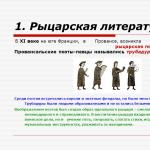"Arc functions" - Arctg t. Definitions. The scope of the function. Arcctg t = a. Function. Y = arcctgх. Arccosx. The set of real numbers. Functional-graphical method for solving equations. Find the meanings of the expressions. Equality. Trigonometric functions. Domain. Properties of arc functions. Definition.
“Algebra “Trigonometric functions”” - Solving homogeneous trigonometric equations. Solving trigonometric inequalities. Trigonometry. Tangent and cotangent. Solving simple trigonometric equations. Arcsine. Content. Trigonometric functions of a numeric argument. Trigonometric functions of angular argument. Solving equations and inequalities.
“Functions of tangent and cotangent” - Properties of functions. Building a graph. Function y = tgx. Numbers. Meaning. Roots of the equation. Graph of the function y=ctgx. Fraction. Solutions. Schedule. Properties of the function y=tgx. Basic properties of the function. y=ctgx. Basic properties.
“Trigonometric graph transformation” - Y=f(x). Graph of the function y=f(|x|). Parallel transfer. Graph of the function y=|f(|x|)|. Stretching. Transforming graphs of trigonometric functions. Graph of the function y=f(x). Cosine function. Sine function. Characteristics of transformations of function graphs. Graph of the function y=|f(x)|. Cotangent function. Tangent function
“Properties of inverse trigonometric functions” - Solve equations. Original equation. Find the meaning of the expression. Solution. Research work. Work in groups. The triple satisfies the original equation. Let's solve the system of equations. Solving equations. Specify the range of the function. Calculate. Arc functions. Inverse trigonometric functions. Elective course in mathematics.
"Function y=cos x" - Y = | cos x |. Domain. Y = - cos x (properties). Function graph. Y = cos (x – a) (properties). Y = cos | x |. Lots of meanings. How to find the domain of definition. Y = cos x + A. Let's extend the resulting graph along the entire number line. Periodicity. Y = k · cos x (properties). Let's find several points to plot a graph.
There are 18 presentations in total
Back forward
Attention! Slide previews are for informational purposes only and may not represent all the features of the presentation. If you are interested in this work, please download the full version.
Lesson objectives:
- To develop in students the ability to depict a graph of a function y=sinx, read its properties according to the graph. Create conditions for monitoring the acquisition of knowledge and skills.
- Developmental - to promote the formation of skills to apply techniques: comparison, generalization, identification of the main thing, transfer of knowledge to a new situation, development of mathematical horizons, thinking and speech, attention and memory.
- Educational – to promote interest in mathematics and its applications, activity, mobility, communication skills, and general culture.
Teaching methods: partially search. Checking the level of knowledge, working according to a generalizing scheme, solving cognitive generalizing problems, systemic generalizations, self-testing, perception of new material, mutual testing.
Forms of lesson organization: individual, frontal, work in pairs.
Equipment and sources of information: Screen; multimedia projector; laptop. Mathematical dictation cards, answers to mathematical dictation questions, cards with written properties of a function y=sinx.
Lesson plan:
- Org moment.
- Repetition of learned material.
- Test work to control knowledge topic: “Reduction formulas.”
- Systematization of theoretical material on plotting the function y=sinx and its properties.
- Explanation of new material.
- Consolidation of new material.
- Summing up the lesson.
- Homework.
During the classes
I. Organizational moment.
(Slide 2)
The French writer Anatole France (1844–1924) once remarked: “You can only learn through fun... To digest knowledge, you must absorb it with appetite.” So, let's follow this advice from the writer today in class, let's be active, attentive, let's absorb knowledge with great desire, because it will be useful to you in your future life. * (MOU Secondary School No. 256, Fokino).
Today we have our first lesson on the topic of trigonometric functions. We will look at their graphs and properties. Let's start studying with the topic: "The function y=sinx, its properties and graph." The task before us is to apply our knowledge and skills when constructing graphs of functions.
II. Repetition of learned material.
(Slide 3)
Subject: " Reduction formulas"
Target: Repeat the rule for using reduction formulas. Focus on the rule model: quarter, sign, function.
1. Consider examples: , , , , .
III. Verification work.
(Slide 4)
Subject: " Reduction formulas"
Target: Control of knowledge and bringing into the knowledge system using reduction formulas.
The work is carried out in two versions, the tasks are projected on the screen. Two students do the same task at the board using cards.
| Option 1 | Option 2 |
The work is over, the students exchange notebooks for mutual checking, two students mark their answers on the screen, and the class comments on the correctness of the assignments. Students monitor the correctness of the test work and give their neighbor a grade. “5” – 5 completed tasks, “4” – 4 tasks, “3” – 3 tasks. Notebooks with test work and completed homework are collected. The grade will be announced at the next lesson, taking into account the completeness of the homework completed.
IV. Systematization of theoretical material.
(Slide 5)
Subject: " Properties of function graphs"
Target: Repeating the description of the properties of the function according to the finished graph.

- domain;
- function zeros;
- intervals of sign constancy;
- increasing, decreasing functions;
- limitation;
- even, odd;
- range;
- find the largest and smallest value of a function on a segment.
V. Explanation of new material.
(Slide 6-8)
Goal: consider the graph of a function; formulate the properties of the function.
Students draw in their notebooks a coordinate unit circle and a coordinate system, for parallel consideration of sine values on the unit circle and plotting points in a prepared coordinate system. After the students understand the principle of constructing a curve, the teacher comments on this work through “cells”. The points are constructed according to the scheme through:
“on the axis”, “corner of the cell”, “almost one”, “one”, then the movement occurs in the reverse order: “almost one”, “corner of the cell”, “on the axis”.
The teacher says that this curve is called a sinusoid.
(Slide 9.)

After constructing a graph, students write down the properties of the function in the same way as they did with the previous function. . In all properties we assume that .
| Function properties |
| function zeros: x=πk, |
| >0 on (2πk, π+ 2πk), |
| <0 на (-π+ 2πk, 2πk), |
| - increases by |
| - decreases by |
| , , |
| , , |
| odd function |
VI. Reinforcing the material covered.
(Slide 10)
Goal: Application of acquired knowledge: finding function values.
“Properties of inverse trigonometric functions” - Inverse trigonometric functions. Oral exercises. Let's solve the system of equations. Elective course in mathematics. Original equation. Arc functions. Solve equations. Work in groups. Research work. Repetition. Solving equations. Term. Calculate. Specify the scope of the function. Solution.
“Function y=cos x” - Y = k · cos x (properties). Y = - cos x. Increasing, decreasing. Y = cos (-x) (properties). Plotting a graph of the function y = cos x. Y = |cos x| (properties). Properties of the function y = cos x. Y = k cos x. Y = | cos x |. How to find the domain of definition. Y = - cos x (properties). Function zeros, positive and negative values.
"Arcfunctions" - Arccos t. Y = arcctgх. Find the meanings of the expressions. Function. Graphical method for solving equations. Expression. Equality. Inverse trigonometric functions. Domain. Trigonometric functions. Arccosx. The scope of the function. Definitions. Range of values. Definition. Functional-graphical method for solving equations.
“Algebra “Trigonometric functions”” - Solving homogeneous trigonometric equations. Reduction formulas. Converting sums of trigonometric functions into products. Formulas for converting trigonometric functions. Formulas for converting the product of trigonometric functions into a sum. Homogeneous trigonometric equations. Sine and cosine.
“Transformation of trigonometric graphs” - Parallel transfer. Stretching. Compression. Graph of the function y=f(|x|). Y=f(x). Part of the schedule. Cotangent function. Graph of the function y=|f(|x|)|. Characteristics of the harmonic oscillation graph. Sections of the resulting graph. Graph of the function y=f(x). Transforming graphs of trigonometric functions. Graph of the function y=|f(x)|.
“Functions of tangent and cotangent” - Function y = tgx. Solutions. Basic properties. Properties of functions. Building a graph. Schedule. Properties of the function y=tgx. y=ctgx. Roots of the equation. Numbers. Basic properties of the function. Meaning. Graph of the function y=ctgx. Fraction.
There are 18 presentations in total
To use presentation previews, create a Google account and log in to it: https://accounts.google.com
Slide captions:
Function y = sin x, its properties and graph. Lesson objectives: Review and systematize the properties of the function y = sin x. Learn to build a graph of the function y = sin x.
y = sin x The domain of definition is the set R of all real numbers: D(f) = (- ∞; + ∞) Property 1.
y = sin x Since sin (-x) = - sin x, then y = sin x is an odd function, which means its graph is symmetrical with respect to the origin. Property 2.
y = sin x The function y = increases on the segment and decreases on the segment [ π /2; π]. Property 3. 0 π /2 π
y = sin x The function y = sin x is bounded both from below and from above: - 1 ≤ sin x ≤ 1 Property 4.
y = sin x y max = -1 y max = 1 Property 5. 0 π /2 π
Let's plot the function y = sin x in the rectangular coordinate system Oxy.
y 0 π /2 π x
First, let's plot part of the graph on the segment. -2 π -3 π /2 - π - π /2 0 π /2 π 3 π /2 2 π X 1 -1 Y x 0 π /6 π /3 π /2 2 π /3 5 π /6 π y 0 1/2 √ 3/2 1 √ 3/2 1/2 0 Now let's plot part of the graph on the segment [ - π ; 0 ], taking into account the oddness of the function y = sin x. On the segment [π; 2 π ] the graph of the function looks like this again: And on the segment [ -2 π ; - π ] the graph of the function looks like this: Thus, the entire graph is a continuous line, which is called a sine wave. Arch sine wave Half wave sine wave
No. 168 – orally. -3 π -5 π /2 -2 π -3 π /2 - π - π /2 0 π /2 π 3 π /2 2 π 5 π /2 3 π X Y 1 -1
Solve exercises 170, 172, 173 (a, b). Homework: No. 171, 173 (c, d)
On the topic: methodological developments, presentations and notes
An interactive test that contains 5 tasks with the choice of one correct answer out of four proposed, taking into account the time spent on passing the test; The test was created in PowerPoint-2007 with...
One of the important terms in trigonometry is cosine. In this presentation, the cosine function will be considered and its graph will be plotted. All the properties it has will be given in detail.

On the first slide, before we begin to consider the function itself, we recall one of the reduction formulas. It was previously demonstrated in detail along with the proof.
This formula suggests that the cosine function can be replaced by sine when certain changes are made in the argument. Thus, having already studied sinusoids, schoolchildren will be able to construct this function. As a result, they will get a graph of the cosine function.


The graph of the function can be seen on the second slide. You can notice that the sinusoid has only shifted by Pi/2. Thus, unlike a sine wave, the graph of the cosine function does not pass through the point (0;0).
The first step would be to consider the domain of definition of the function. This is an important point and this is where the analysis of any function in mathematics begins. The domain of definition of this function is the entire number line. This is clearly visible in the graph of the function.


Unlike the sine, the cosine function is even. That is, if you change the sign of the argument, the sign of the function will not change. Parity is determined by the property of sine.


At certain intervals the function increases, at certain intervals it decreases. This suggests that the cosine function is monotonic. These intervals are shown on the next slide. On the graph you can clearly see the increase and decrease of the function.


The fifth property is limitation. The cosine function is bounded both above and below. The minimum value is -1 and the maximum is +1.


Since there are no break points or sharp peaks, the cosine function, like the sine function, is continuous.

The last slide summarizes all the properties that were discussed in the presentation. These are a number of basic characteristics that the cosine function has. Having memorized them, you can easily cope with a number of equations that contain cosine. It will be easiest to master these properties if you fully understand the essence.




